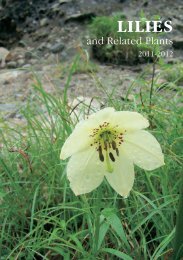LILIES - RHS Lily Group
LILIES - RHS Lily Group
LILIES - RHS Lily Group
Create successful ePaper yourself
Turn your PDF publications into a flip-book with our unique Google optimized e-Paper software.
initiate a programme of chromosone counts of lilies. Sir Daniel Hall agreed to<br />
carry out the work at the John Innes Horticutural Institution, and the Bentham<br />
Trust donated £25 towards the costs of the work (“thus no financial burden<br />
would fall upon the Society”). The result of this labour was a three-part article<br />
in the 1934 Year Book.<br />
In co-operation with staff of the <strong>RHS</strong> Garden at Wisley a number of research<br />
projects were proposed and commenced. There is virtually no record of the<br />
results in the minutes of the <strong>Lily</strong> Committee. Thus we read of experiments<br />
on the influence of water levels and drainage, attempts to grow lilies in pits of<br />
different soils, the study of root development in lilies, systematic comparison of<br />
methods of scaling and measurement of carbon dioxide levels around the bulbs<br />
of imported lilies together with its effect on storage rots. Like all contemporary<br />
biological research, not merely in horticulture, the experiments and trials were of<br />
an empirical nature and their design and objectives seem simplistic in the extreme<br />
by comparison with modern work chronicled later in Dr Waister’s article 2 .<br />
In 1934 Stoker began pressing for the collection of data on the identification<br />
of lily bulbs, the eventual result of which was W. A. Constable’s article “The<br />
Comparison of <strong>Lily</strong> Bulbs” in the 1946 Year Book (the original drawings for<br />
which are in the Lindley Library). Some proposals never reached fulfilment,<br />
among them Arthur Groves’ projected “synonimicon” of lilies and Thomas Hay’s<br />
demand for a comprehensive bibliography of lily literature.<br />
After the conclusion of the 1932 Conference, the <strong>Lily</strong> Committee’s meetings<br />
were largely devoted to show schedules and the publication of the Year Book;<br />
almost the only technical discussion recorded in the minutes was the debate over<br />
whether or not Lilium duchartrei and L. lankongense were distinct species. By<br />
1937 the Committee could record the verdict of J.D. Stewart of the <strong>Lily</strong> Garden,<br />
Oregon City, that “For some years we have regarded these Year Books as our<br />
most valuable source of information on lilies, and we appreciate this good work<br />
of the Royal Horticultural Society”.<br />
In 1939, the Reverend Professor E.S. Lyttel presented a silver cup “to be<br />
awarded annually on the recommendation of the <strong>Lily</strong> Committee to someone<br />
who has done good work on behalf of Lilies, Nomocharis or Fritillaries” 3 . The<br />
first recipient of the Lyttel Cup was Arthur Grove, for his publications which “in<br />
2 Review of the <strong>Lily</strong> Literature 1988-1991 published in Lilies and Related Plants 1992-1993,<br />
(pp. 99-105).<br />
3 Professor Lyttel also presented a silver cup for a similar purpose to the Alpine Garden<br />
Society, which embodied his other great horticultural interests. That original cup is still<br />
awarded today. The first Lyttel Cup presented to the <strong>Lily</strong> Committee has disappeared,<br />
presumably into a melting pot. The one presented today is a smaller cup created at a<br />
later date but still known as the Lyttel Cup.<br />
32




